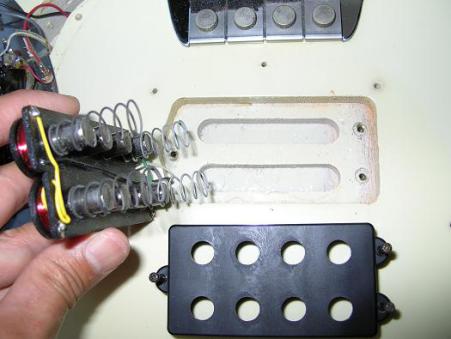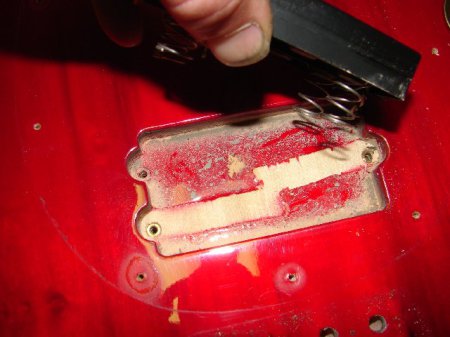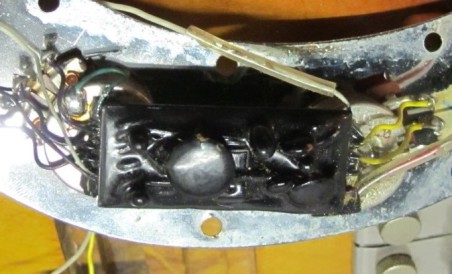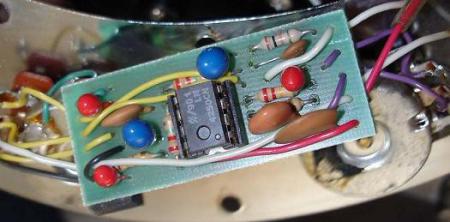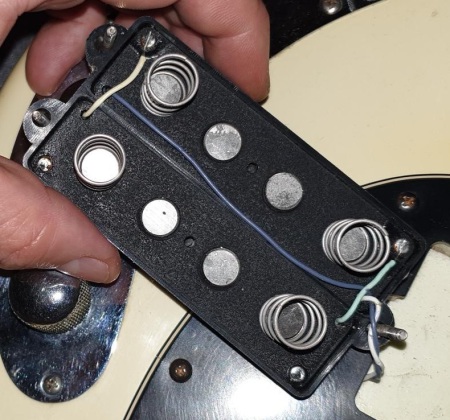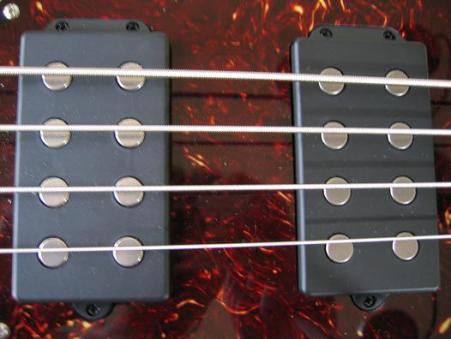Formerly MUSICMANBASS.ORG
SR4 PUPs AND PREAMPS
Pre-EB & EB (Part 1)
Note that updates introduced were often gradual as Music Man continued
using their existing superseded stocks until depleted.
Pre-EB Pickups (1976 - 1983)
1976 to Circa Second half of 1977 (First Version).
Pickup from Sting Ray Bass dated Jan/Feb 1977.
The pickup consists of two
separate coils wired in parallel to cancel hum.
Note that the pole pieces extend below the pickup cover. Each pole piece is 1 inch long and 3/8 inch diameter. The resistance of each coil is approx 2,400 - 2,600 ohms. As both coils are
wired in parallel, the total resistance of the pickup is approx 1,200 - 1,300 ohms.
The resistance is considerably lower than the newer pickup introduced c. second half of 1977 (see further on).
Note that coil windings varied due to techniques used at that time. This resulted in slightly different resistance readings between individual pickups.
Sting Ray pickup and body routing. Body date
17 June 1977. Courtesy "calzone".
The pickup cavity has a further lower routing to accommodate the extended length of the pole pieces.
Throughout the Pre-EB (and EB period), Sting Ray 4 pickups are passive (not active), the coils
are wired in parallel and pole pieces are Alnico. The battery powers the pre-amp only.
Circa Second half of 1977 to end of Pre-EB period [1983] (Second Version).
Above two pics showing side and bottom views of
the new pickup (from a late 1978 Bass).
It is believed that the original pickup was intermittently prone to cutting out when bending strings along with hard playing.
Pole pieces are now shorter
(5/8 inch length) and flush with the bottom of the pickup cover. The pole pieces remain the same 3/8 inch diameter. Each coil now has a higher resistance of approx 3,900 ohms. As both coils are
wired in parallel the total resistance of the pickup is approx 1,950 Ohms.
Note again that, as with the first version pickup, coil windings varied due to techniques used at the time. This resulted in slightly different
resistance readings between individual pickups.
Above two pics. New pickup used in conjunction with the
older original pickup routing. Body date 10 Mar 1978.
Examples can be found up to late 1978.
Although the new pickups had shorter pole pieces, the older original pickup routing remained unchanged for a period. Perhaps this was to allow the use of either the newer or the oldere pickups until stocks of the older were depleted. Examples of the newer pickup used with the older original pickup routing can be found on bodies up to late 1978.
First Revision Of Pickup Routing (Circa 2nd half of 1978):
Body 11 August 1978. B007512.
Body 20 Oct 1978. B008160.
Above two pics. A new pickup routing introduced just prior to the deletion of the older pickup routing in late 1978.
Second Revision Of Pickup Routing (Circa Beginning Of 1983):
Abovr. Body 3 Mar 1983.
From circa Feb/ March 1983 the pickup routing outlines the pickup's cover. It is thought that the new routing may have coincided with the introduction of clear
pickguards.
Suggested Substitutes For The Pre-EB Pickups (No
affiliations).
First pickup above: Made by Curtis Novak Classic Pickups. Appear to be a suitable substitute for the original First Version pickup refered to at the outset (long pole pieces extending below the pickup cover).
Second pickup above: Made by Nordstrand. The"MM 4.2" is designed around the Second Version pickup which extends into the Ernie Ball Music Man period up to mid 2018. Thereafter, the SR4 pickups moves to Neodymium as opposed to Alnico. NB It's also a suitable substitute for the First Version pickup although without the longer pole pieces.
Pre-EB PREAMPS (1976 - 1983)
Intro.
All Pre-EB preamps are 2 Band EQ (ie 2EQ). Although the Treble and Bass controls have no centre detent
position, the preamps are CUT and BOOST. With respect to the treble control, the cut and boost takes place during normal clockwise/anticlockwise rotation of the control. The flat position is approx.
mid way through rotation. On the other hand, the cut position on the bass control appears to be at the extreme anticlockwise position of rotation and begins to boost as the control is advanced
clockwise from that point.
Pot resistances and tapers.
Volume: The preamps use a 25K
ohm audio (log) taper pot for the volume control. Towards the end of the Pre-EB period it changes to a linear taper to make adjustment smoother throughout rotation (see further
on). The audio taper tends to cram the volume adjustment to the upper limit of the pot rotation.
Treble: A 1Meg ohm reverse audio (log) pot is used for treble control.
Bass: A 100K ohm audio (log) pot is used for the bass control.
IC Chip.
All preamps use an "LM4250CN" IC chip. The same chip and pot values are also used on all Ernie Ball 2EQ pre-amps to current date.
Pot Dating.
1979 pot with code dating on the side.
Preamp pots are coded to identify the manufacturer & the date of manufacture. For example "1377626". The "137" component is the code for the manufacturer which, in this case, is CTS ("Chicage Telepnone Supply"). The next two numbers are the year of manufacture ("76" for 1976). The remaining two numbers are the week of the year ("26" for the 26th week of 1976) which is June. The code example "1377626" therefore identifies the pot as being manufactured by CTS in June of 1976. Pot dates do not necessarily identify the date of the preamp. As Music Man purchased pots in large quantities it’s not unusual to find pots that are dated one to two years earlier than the pre-amp itself. Some 1979 pots can be found on early Ernie Ball Bass preamps.
Pot Wiring.
The above pots have lugs for point to point wiring. These are used throughout the Pre-EB period and up to c.1990 during the Ernie Ball Music Man period. Thereafter, the pot lugs are generally replaced with pins to allow direct soldering to circuit boards. In Sept 2009 the pots became physically smaller with the use of "Noble"branded pots. In all cases the pot resistance values and tapers have remained the same.
An exception to the above is with the "Old Smoothie" Bass (2016-2020) which comes with a "black epoxy" preamp that uses the original lug pots of the same size, resistances and tapers. As this Bass is not currently offered, the pots may or may not be available from Ernie Ball.
Detaiks are:
Volume control pot. 25K Ohm Linear taper. Part no. "MC 120W".
Treble control pot. 1 Meg Ohm Reverse Audio taper. Part no. "MC 122W".
Bass control pot. 100K Ohm Audio taper. Part no. "MC 121W".
Battery.
Battery clip from a 1979 Sting Ray.
The above battery clip is used on all Music Man Basses from 1976 to the end of the Pre-EB period. Available, at current
date, from both "Keystone Electronics" (Battery Strap & Lead part no. 83) and "RS Components" (Keystone Strap & Lead stock no. 162-9078).
1976 to early 1977 (Black Epoxy).
1976 preamp. Note the out-board capacitor within
the red rectangle in above pic.
From 1976 to early 1977 a red/orange coloured outboard capacitor is located on the treble pot rather than being included on the circuit board itself. Subsequent preamps have all components on the board.
Preamps are sealed in black epoxy. The IC chip is soldered direct to the circuit board. The sequence of lead-out wires from the board is completely different to subsequent Pre-EB preamps boards.
Schematic preamp wiring for 1976 and early 1977 Basses.
1977 to 1978 inclusive (Black Epoxy).
There appears to be
three versions of the preamp used during this period.
Type 1.
Pics of type 1.
Type 1 schematic.
Type 2.
Type 2 schematic.
Note that the lead-out wires to the bass pot (on right) are now yellow instead of violet and have been reduced from three to two. The bottom lug of this pot is now unsoldered (as opposed to Type 1 above). The three lead-outs on the left are now violet as opposed to yellow. Note also that the two black/white lead out wires to the volume pot have had their positions reversed as opposed to Type 1. White now goes to the centre lug of the volume pot and black to the bottom lug.
Type 3.
Type 3. Webmasters 1978 preamp.
Type 3
Schematic.
Note that the lead-out wires to the bass pot revert back to being violet. This pre-amp appears to be the main one used towards the end of 1978.
Some preamps (including the 1976) may look slightly different to the example pics above. This is due to the physical dimensions of different components used at various times during manufacture. The lead-out wires and colouring remain the same.
Sept 1978. Non-Epoxy Preamps Introduced.
A 1979 non-epoxy preamp. (Pics courtesy of "freedok").
Note the red and blue coloured Tantalum capacitors.
Green and maroon Tantalums were often used
as well. On latter preamps, Electrolytic
capacitors become standard c.1982.
From Sept 1978 a
non-epoxy version of the Type 3 black epoxy preamp was introduced and began replacing the former black epoxy version. This extended over a period of several months due to existing stock of the
black epoxy still being used until depleted. Consequently, Basses made from Sept 1978 up to, and including, early 1979 can have either a black epoxy preamp or a non-epoxy preamp.
Putting aside the deletion of the epoxy, the two versions (either epoxy or non-epoxy) are the same as each other. Both use the same circuit board which is designated “B3”. Also the wire
lead-out orientation and lead-out colours remain the same for each.
The IC chip for the non-epoxy version is now mounted to the board via an IC socket rather than soldered directly to the board itself. However, from 1984 (beginning of the Ernie Ball period) all
ICs returned to being soldered directly to the circuit board. Note that some old stock Pre-EB boards may have been used during the early EB period as well.
Wiring schematic for the non-epoxy preamp is exactly the same
as for the Type 3 epoxy preamp used during
the 1977-1978 period above.
Although a switchable output jack is introduced circa second half 1979 and referred to below, the same non-epoxy rectangular preamp and colour coding is used to the end of the Pre-EB period. It is also used by Ernie Ball from 1984 to 1990 (see further on). From 1990 the circuit board has changed its shape several times but the 2EQ circuit itself still remains the same to current date.
Circa 2nd Half 1979. New switchable output jack introduced.
At left is the non-switchable jack first used with Pre-EB
preamps. The jack (right), introduced circa
2nd half 1979, disconnects the battery
when the guitar lead is removed.
Initially, all
pre-amps remained permanently turned on. Removal of the guitar lead did not disconnect the battery. Current drain was considered to be low enough for the battery to last its normal shelf life whether
left connected or not. A newer jack was introduced circa 2nd half 1979 to disconnect the battery. This is the position with Basses to current date. Jacks are available from Ernie Ball's
customer srvice.
March 1982. Protection Resistor
Introduced.
29 March 1982 schematic showing where
protection resistor
is placed in circuit. Also shown is the new switchable
output jack introduced circa 2nd half
1979.
Reproduced with permission.
Although updated with both a protection resistor and switchable output jack, the preamp and other hookup wiring otherwise remain the same.
Protection resistor installed by the factory and covered
with a black plastic sleeve. Also shown is the new
switchable output jack.
The IC chip
can be damaged if the guitar lead becomes short-circuited (even momentarily). In 1982 the addition of an out-board 1K ohm protection resistor was recommended, and subsequently used, to protect
the IC chip.
NOTE: The protection resistor is used in all new preamps, after its introduction, whether using either Tantalum or Electrolytic
capacitors.
1982. Linear
Taper Replaces Audio (Log) Taper on Volume Control.
Volume pot is now linear taper rather than audio (log). Note
linear ("LIN") identification marked on rear. Above
example is a mid 1982 pot. (Courtesy LUVLITE
Recordings Switzerland).
The previous 25K audio (log) taper pot for the volume control tended
to cram up the volume control adjustment from approx mid point to the end of pot rotation. The linear taper corrects this by allowing a smoother adjustment throughout the whole
pot rotation.
It's possible that some new linear pots may be found in preamps leading up to 1982.
Circa 2nd half of 1982. Electrolytic Capacitors Replace Tantalums.
The "LM4250CN" chip as used in the preamps (left),
Electrolytic capacitor (centre) and a
Tantalum capacitor (right).
Above. Two preamps from 1982. Both are factory-fitted
with the protection resistors introducfed Mar 1982. Top
usesTantalum capacitors. Bottom uses Electrolytic.
Electrolytic capacitors begin replacing Tantalums circa second half of 1982. Audiophiles believe that the electrolytic has a more mellow tone.
End of 1982. All official Music Man updates of the Preamp board completed.
Final schematic with all official Music Man preamp updates ie switchable jack, protection
resistor, "Linear" tapered volume pot and electrolytic
capacitors.
Front and rear pics of Webmasters N.O.S. 1983 preamp.
Music Man covers the protection resistor with
a black plastic sleeve prior to installation .
The Ernie Ball replacement preamp for
all Pre-EB &
EB (2EQ) Sting Rays up to 1990 which use a
the rectangular circuit board.
The 2EQ circuit is the same today as it was in the Pre-EB period.
However, the circuit board changed shape c,1990.
The protection resistor is now included on the board. See EB preamps from 1984 (below).
Reproduced with permission. A schematic wiring diagram for
the M05400 replacement board directly above.
Note the violet coloured lead-out wire on the left side of the board as opposed to the "1982 To End Of Pre-EB Period" schematic (above) with yellow, yellow & yellow lead-outs. However, the preamp, the lead-out and hook up wiring sequences are the same. The protection resistor is included on the preamp board. The replacement board can be used on all Pre-EB Basses (including 1976) if the replacement wiring schematic is followed. All Pre-EB Basses (including 1976) have the same value pots for volume, treble and bass controls.
EB Pickups (From
1984)
OVERVIEW.
Pre-EB pickups (above) varied individually due to winding techniques adopted at that time. Ernie Ball automated the windings to make the pickups more consistent.
As with the Pre-EB Sting Ray pickups, Ernie Ball Sting Ray 4 (SR4) pickups are passive, the coils are wired in parallel and pole pieces are Alnico. The battery powers the pre-amp only.
Similarly, as with the second version of the Pre-EB pickup from circa second half of 1977 onwards (above), pole pieces measure 5/8 inch in length with a diameter of 3/8 inch. Each coil
measures approx 3,900 ohms with a total output of approx 1,950 ohms (in parallel).
From a 1987 SR4. Same Yellow and Green coloured
wires as used with the Pre-EB pickups. Courtesy
Nicola (Italy).
Above two pics from a 1989 SR4. Note the
wires
change to Orange and Blue. The coils still have
no outside tape winding.
From a 1992 SR4 (courtesy "Oliver"). Wire
at right hand
side is now Green. The owner advises this pickup has no
outside tape winding on the coils. The metalic shielding
tape across the pole pieces is an after-market
modification and is not original
from the factory.
Above two pics from a 1994 SR4. Note, for first time, the
inclusion of a winding of Black tape over the coil
windings. It's unknownif this was the
case in 1993.
A more recent SR4 pickup (exact vintage unknown). As
with other pickups the Black lead-out wire is
"Ground" (earth). The White lead-out
goes to the pre-amp (input).
Mid 2003. Bevelled pole piece edges introduced.
SR4 Pickup with bevelled Alnico pole pieces. Introduced
mid 2003. In all other respects the pickup remains
the same. (Picture "Davtran").
2005 July NAMM. Dual pickups introduced.
Above. Introduced July 2005. An
SR4 with dual
Humbucker (HH) pickups. (Pic "Steve Barr").
Close-up view of dual Humbucker pickups (HH).
(Picture "hmagman").
In addition to the
single Humbucker pickup Sting Ray 4 (SR4H), the new dual pickup Sting Rays were introduced at the July 2005 NAMM Show. Pole pieces remained Alnico with bevelled edges. The pickup covers differed
slightly to the SR4H covers in that the area on the side supporting the two height adjustment screws are one-piece (similar to the pickup covers featured on the Bongo
Basses).
As well as two Humbucker pickups (SR4HH), the SR4 was also available with a combination of one Humbucker pickup and a Single coil pickup (SR4HS).
The SR4HH and SR4HS were only available with a 3 Band EQ preamp (ie 3EQ). There was no option of the 2 Band EQ preamp (ie 2EQ). However, the single
Humbucker pickup Sting Ray SR4H was available with either the 2EQ or the 3EQ preamp. The Ernie Ball 2EQ is discussed below. The Ernie Ball 3EQ (introduced in 1987) is
discussed further on.
July 2018. Neodymium pole pieces EXCEPT Classic Collection & Old Smoothie.
With the next generation Sting Ray Bass Special 4 (and 5), introduced in July 2018 and replacing the regular SR4 Bass (and SR5) altogrther, single and dual pickups now have Neodymium pole pieces. Included is a new re-voiced 3EQ 18 volt preamp. There is no 2EQ 18 volt preamp version nor is there a choice of having the 2EQ 9 volt preamp. However, the Sting Ray Special does not replace the Classic Collection nor Old Smoothie Sting Rays which still retain their Alnico pickups and thier related 2EQ 9 volt preamps (see further on).
EB 2EQ PREAMPS (From 1984)
Introduction.
The Ernie Ball 2EQ preamp (to
current date) is the same circuit as the Pre-EB non-epoxy 2EQ preamp as it was at the end of the Pre-EB period. Although the IC chip "LM4259CN" remains the same, it now
becomes soldered directly to the circuit board and not via an IC socket. However, some Pre-EB boards are used in very early EB Basses. The out-board protection resistor modification (from
1982) becomes relocated to the board in 1986.
Wiring of the preamp board to the pots, pickup and jack also remains the
same as does the sequence (and colours) of the lead-outs from the preamp board.
The board shape changed from rectangular to crescent moon in circa 1990 but the circuit remains electrically the same (as do pot values) to current date.
1984 to 1986 (2 band).
Ernie Ball (EB) continues with the Pre-EB 2EQ Sting Ray preamp
as it was at the end of the Pre-EB period.
A 1985 preamp. The protection resistor is covered
with a black plastic sleeve (on left).
A 1985 preamp (body date 6 Aug 1985).
The 1985 preamp (above) still has the outboard protection resistor. The red arrow shows the position of where the
protection resistor is to be relocated to the preamp board in 1986.
Circa 1986 to circa 1990 (2 band).
A 1986 preamp. Protection resistor relocated
to the
board (encircled). Neck date 24 Sept 1986. Body
date 8 Jan 1987.
The protection resistor is now relocated on the circuit board in
1986.
Schematic for the EB 2EQ preamp from 1986 to 1990.
Above two pics. Top is preamp dated 12
Nov 1987 with
black marker pen on rear of control plate. Bottom is
preamp dated 21 July 1988 with a round
sticker
on rear of a control pot.
Pre-EB preamps and early EB preamps are not dated until
early 1987. Initially this is hand written with a black marker pen on the rear of the control plate. Note that some earlier black marker pen markings (starting from c. latter half
of 1985) don't record a date at all. Instead, the word "OK" appears (and maybe a signature as well). Perhaps the "OK" is to indicate that the wiring has been tested and is working
correctly. From circa mid 1988 the date is recorded on a round sticker attached to the rear of either the volume or bass control pot.
Preamp dates appear to be records of when the preamp assembly is made which can be up to several months prior to the date of birth of an instrument. Sometimes preamp pots can be dated much earlier than the preamp assembly date as pots may have been purchased in large quantities. It's not unusual to find bass control pots dated 1979 on early EB preamps.
The Ernie Ball replacement preamp
board ("M05400")
for all Pre-EB & EB Sting Rays up to 1990 which use
the same board shape. The protection restor is
included on the board
(encircled).
Underneath view of the replacement board. The board is
designated at the bottom with "B 3A". Note that the
last of the Pre-EB boards were designated "B 3".
As well as being designated "B 3A", three of the leadout wires on the left are violet, yellow and yellow rather than the normal three yellow wires.
Reproduced with permission. A schematic wiring diagram for
the "M05400" replacement board directly above.
Note that the leadout wire colours on the left side of the circuit board are yellow, yellow & violet. Preamps already fitted to Basses up to 1990 are yellow, yellow & yellow. Other than that, the replacement preamp is the same.
As from circa 1990 (below), most preamp circuit boards are redesigned to allow the Volume, Treble and Bass control pots to be mounted directly to the boards themselves. However, the M05400 preamp replacement board (directly above) can be substituted along with control pots being mounted directly on the control plate. The 2EQ preamp circuit itself (and the pot values) all remain the same.
Circa 1990-Sept 2009 (2 band).
Pots used with preamps.
Up to this stage, pots have had lugs for point to point wiring (above left). From circa 1990, direct mount pots (above centre) have been used in 2 band preamps due to the circuit board design (see below). As the pot values (and tapers) remain the same, the direct mount pots can be modified for use in the earlier preamps by bending and cutting the pins (above right).
The 2EQ preamp with a new circuit board design.
From circa 1990, the 2 band pre-amp circuit board changed from rectangular to crescent moon. Note that the lug pots are replaced with direct mount pots that solder to the circuit board with pins. The circuit remains the same as the earlier preamps.
Reproduced with permission. Schematic
wiring for 2 band
preamps from circa 1990 to Sept 2009.
Sept 2009-July 2018 (2 band). Regular SR4 ceases to be offered July 2018. The new lightweight "Special" SR4 offered in place of the Regular SR4. (The "Special" SR4 electronics are dealt with in Part 2 below)
Above two pics of the newer 2EQ preamp
introduced
in September 2009. (Pics courtesy of Mike).
The circuit remains the same and continues to use the LM4250CN chip. Although pot resistance values also remain the same, the previous larger pots are replaced by physically smaller "Noble" pots which make no change to the voicing of the preamp. [3EQ preamps had already changed to Noble pots 3 years earlier in Oct 2006].
Schematic wiring for the SR4 2EQ as from 2009. This also applies
to the "Classic Collection" SR4 below.
2010 - July/Aug 2020 "Classic Collection" SR4 & SR5 ceases to be offered July/Aug 2020
Preamp from a 2011 "Classic Collection" SR4. See
schematic directly above for wiring.
The "Classic Collection" SR4, SR5 and Classic Sterling all use the same 2EQ preamp and board as updated for the regular SR4 in Sept 2009 (above). The preamps are not coated with black epoxy.
2016-July/Aug 2020. "Old Smoothie" 40th Anniversary SR4 (& Subsequent "Old Smoothie" Basses) ceased being offered July/Aug 2020.
Black epoxy preamp as fitted to the 2016 "Old Smoothie"
40th Anniversary & subsequent "Old Smoothie"
Sting Ray Basses.
The "Old Smoothie" SR4 is based on Sterling Ball's 1976 Pre-EB Sting Ray (B001026) made for him by Leo Fender. Although the Smoothie preamp is designed around the original 1976 preamp, it does not have the same 1976 hookup wiring but rather the same leadout colours and hookup wiring as the EB preamps from 1986 to 1990. Pot values remain the same. Pots have the same physical dimensions as Pre-EB pots and not the smaller Noble pots.
Not an official "Old Smoothie" schematic but a 1986-1990 EB schematic.
This is the same wiring as the "Old Smoothie"
black epoxy preamp wiring.
"Old Smoothie" is the only EB preamp to be sealed in black epoxy since its deletion during the Pre-EB period.
the previous
July 2018- Current. New lightweight "Special" SR4 introduced with new re-voiced 18 volt 3EQ preamp & Neodymium pickups. In general, no more 9 volt 2EQ preamp & Alnico pickups. It is unknown if/when the Regular SR4, the Classic SR4s and Old Smoothie SR4 will be offered again in the future.
With the next generation Sting Ray "Special" , introduced July 2018, and offered in place of the regular SR4,
the 2EQ 9 volt preamp is replaced with a new re-voiced 3EQ 18 volt preamp. The previous brass control plate is now teplaced with aluminium (chrome or black). The pickup now has
Neodymium pole pieces rather than the previous Alnico. There is no 2EQ 18 volt preamp version for the Sting Ray Special. The
2EQ 9 volt preamp and related Alnico pickup is not an option.
Putting aside the above, the subsequent limited releases below still retain their original electronics:
*Nov 2020. Icon Series "Cliff Williams" (AC/DC) Sting Ray Limitede
Release.
As from Nov 2020 the Cliff Williams Sting Ray is the first subsequent Bas to have the 2EQ 9 volt preamp along with its related Alnico pickup. Approx 26 offered.
*Spring 2023. BFR 1976 Sting Ray.
2EQ 9 volt preamp along with its related Alnico pickup. 100 offered.
*June 2023. 45th Anniversary 1976 Prototype Sting Ray.
Was to be offered in 2021 but shelved till June 2023 due to Covid. 2EQ 9 volt preamp along with its related Alnico pickup. Only 5 offered.
*Oct 2023. Retro 70's Sting Ray.
2EQ 9 volt preamp along with its related Alnico pickup. White, Sunburst, Blac or Natural.
EB 3EQ PREAMPS (1987 - Current)
Continued in Part 2 (includes the new re-voiced 3EQ 18 volt preamp):
HERE
Home About
Musicmanbass.global & Contact 1978 Hangtag
Manual Serials Pre-EB Sting
Ray Serials EB Sting Ray 4 Serials Pre-EB Cutlass 1 & 11
Serials Pre-EB Sabre Serials EB Sabre Serials Sting Ray 5 Serials
Sterling Serials American SUB
SR4 PUPs and Preamps Pre-EB & EB (Part
1)
SR4 PUPs and Preamps Pre-EB & EB (Part
2) Bridges Pre-EB &
EB Neck Plates Pre-EB & EB
Headstock Logos (Part 1) Headstock Logos (Part 2) Bass Collecftions No.1
Bass Collections
No.2





